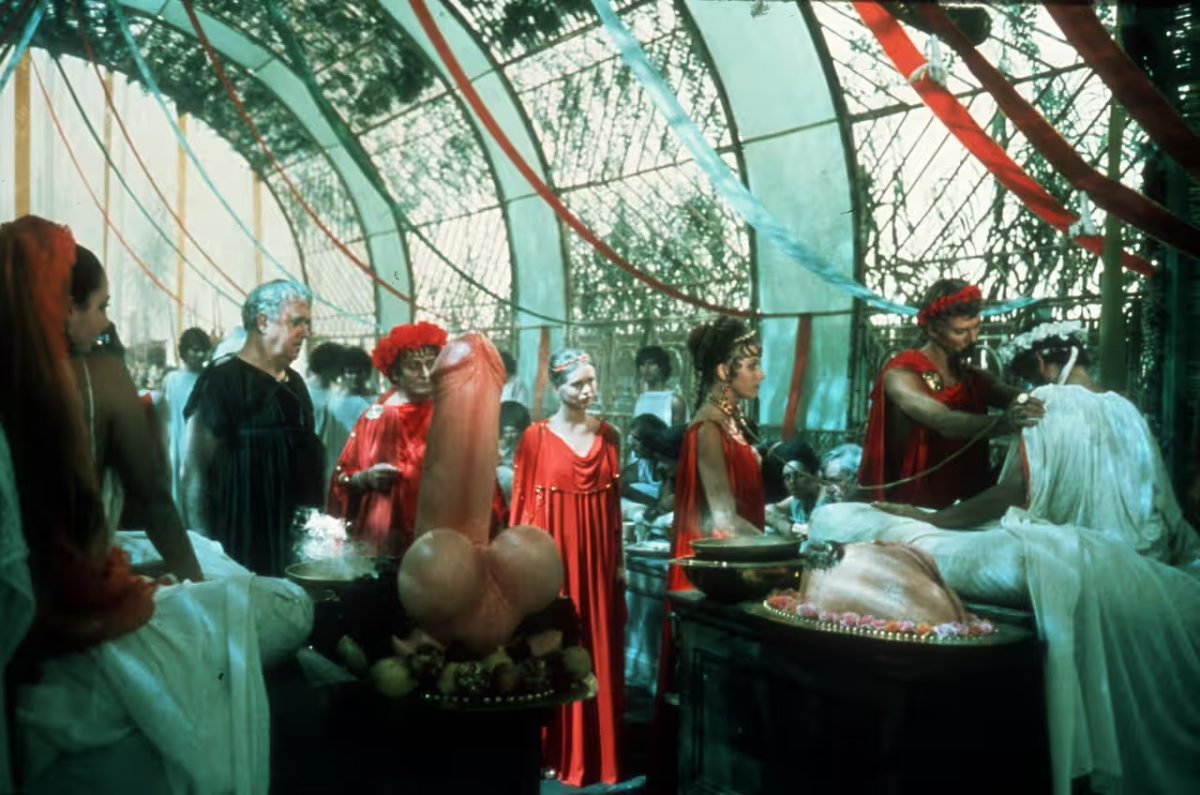Dubbed by its original screenwriter, Gore Vidal, as “undoubtedly one of the worst films ever made,” Caligula has undergone a transformative re-editing process under the guidance of Thomas Negovan, culminating in its recent premiere. Here later I will quote from artist charged with the update Negovan who delves into the rationale behind his decision to revisit this swords-genitals-sandals shockfest.

Embarking on an audacious and quixotic endeavour, Negovan faced the daunting challenge of working with a staggering 96 hours of raw footage captured during one of the most chaotic and tumultuous shoots in cinematic history. His aim was to craft a new version of the film that Variety, upon its original release in 1979, labeled as “a moral Holocaust.”
Step forward Thomas Negovan: the man to try and rescue Caligula. “There were definitely a lot of points in the last three years where I thought I was crazy,” he says. “I thought: ‘Is anyone going to care about this?’” But, in fact one of the most important entities in the industry, the Cannes film festival, cared very much, booking the new-and-possibly-improved version a premiere in its prestigious Cannes Classics strand, a section of the festival generally dedicated to celebrating the art of cinema at its finest.
“And so all of a sudden, I thought: ‘OK, all the therapy bills are worth it,’” said Negovan.
Screened for the first time just last Wednesday, the 2023 version is billed as Caligula: The Ultimate Cut, and Negovan is keen to point out that, “The thing that’s bizarrely unique about it is it’s almost like the version that was released in 1979 is the deviant version. Ours is closer to what was originally intended. Even the word restoration … I don’t know what word works, but it isn’t a restoration. I don’t know what to call it.”
The original film Caligula, directed by Tinto Brass and produced by Bob Guccione, is renowned for its controversial nature. Despite having a triple platinum cast of post Clockwork Orange fame Malcolm McDowell, Helen Mirren, Peter O’Toole and Sir John Gielgud, somewhere along the way, it seemed to have been hijacked by someone wanting to make a porno flick, I wonder who that was ? Throughout its production and upon its release, the film faced numerous dramas and challenges that contributed to its enduring notoriety. Let’s explore the dramas surrounding the making of Caligula and its reception post-release. By exploring its background, controversial themes and content, pre-release drama, and post-release reception and legacy, we may just gain a deeper understanding of the impact and significance of this controversial film.
Caligula originated from the collaboration between producer Bob Guccione, founder of Penthouse magazine, and director Tinto Brass. The film aimed to depict the life and reign of the Roman Emperor Caligula, known for his debauchery and tyranny. The screenplay, initially written by renowned author Gore Vidal, underwent significant modifications during production, shifting the film’s tone and direction. The initial vision for the film was grand, with an extravagant budget, elaborate sets, and the involvement of esteemed actors.
Caligula pushed the boundaries of explicit content in cinema, featuring graphic violence, sexual content, and depictions of incest. Tinto Brass’s artistic choices, including his use of explicit imagery and provocative scenes, contributed to the film’s controversial reputation. The film’s exploration of power, decadence, and human depravity raised ethical questions regarding its content and its potential impact on viewers. While some argue that the film’s explicit nature was necessary to portray the depravity of the era accurately, others criticise it as gratuitous and exploitative.
The making of Caligula was marred by conflicts, creative disagreements, and casting controversies. Tinto Brass clashed with the producers, leading to tensions over the film’s direction and final cut. Notable actors, including Peter O’Toole and John Gielgud, withdrew from the project due to its explicit content, leading to the replacement of key roles. The film also faced censorship battles, with various versions edited to comply with content restrictions. Distribution challenges and legal issues, such as copyright disputes and financial setbacks, further complicated the film’s production. These dramas and challenges significantly impacted the film’s timeline, budget, and overall perception.
Upon its release in 1979, Caligula received polarised reviews from critics. While some praised its audacity and artistic vision, others condemned its explicit content and perceived lack of narrative coherence. The film’s box office performance varied, with commercial success in some markets and failure in others. Despite the mixed critical response, Caligula developed a cult following over time, becoming a landmark in controversial cinema. Its influence on subsequent films tackling similar themes is evident, with filmmakers drawing inspiration from its audacity and willingness to challenge societal norms.
Caligula’s controversies, both during its production and after its release, have cemented its place in cinematic history. While the film faced numerous challenges and criticism, its enduring notoriety and cult following attest to its impact. Caligula raises important debates surrounding the artistic merits and ethical implications of controversial film material. Could it be the next Barbie?
Subscribe to FIB’s Weekly Breaking News Report for your weekly dose of music, fashion and pop culture news!







